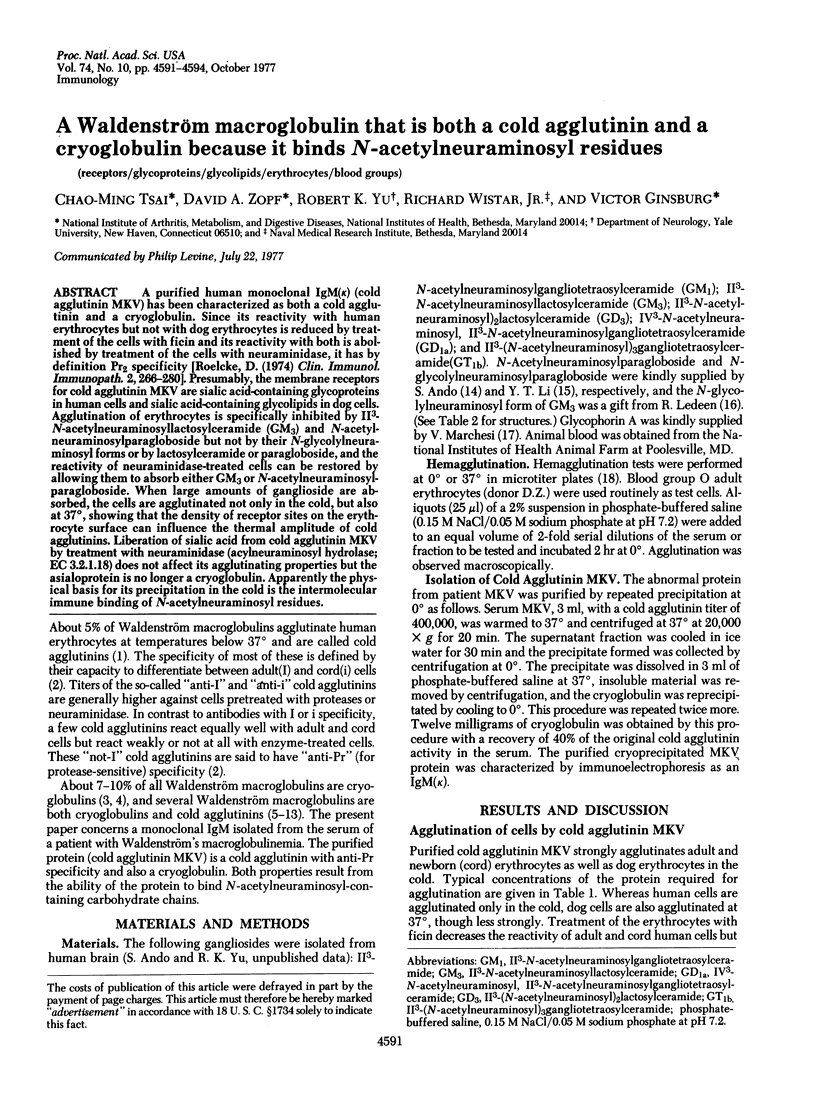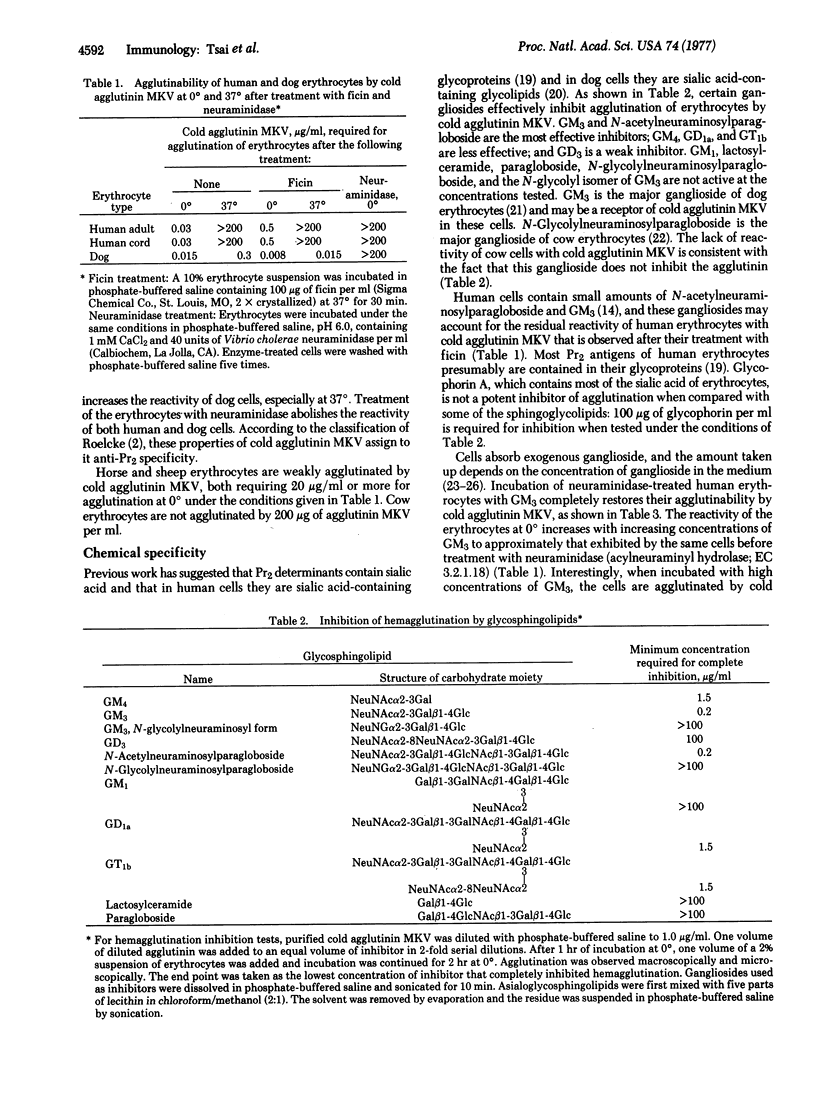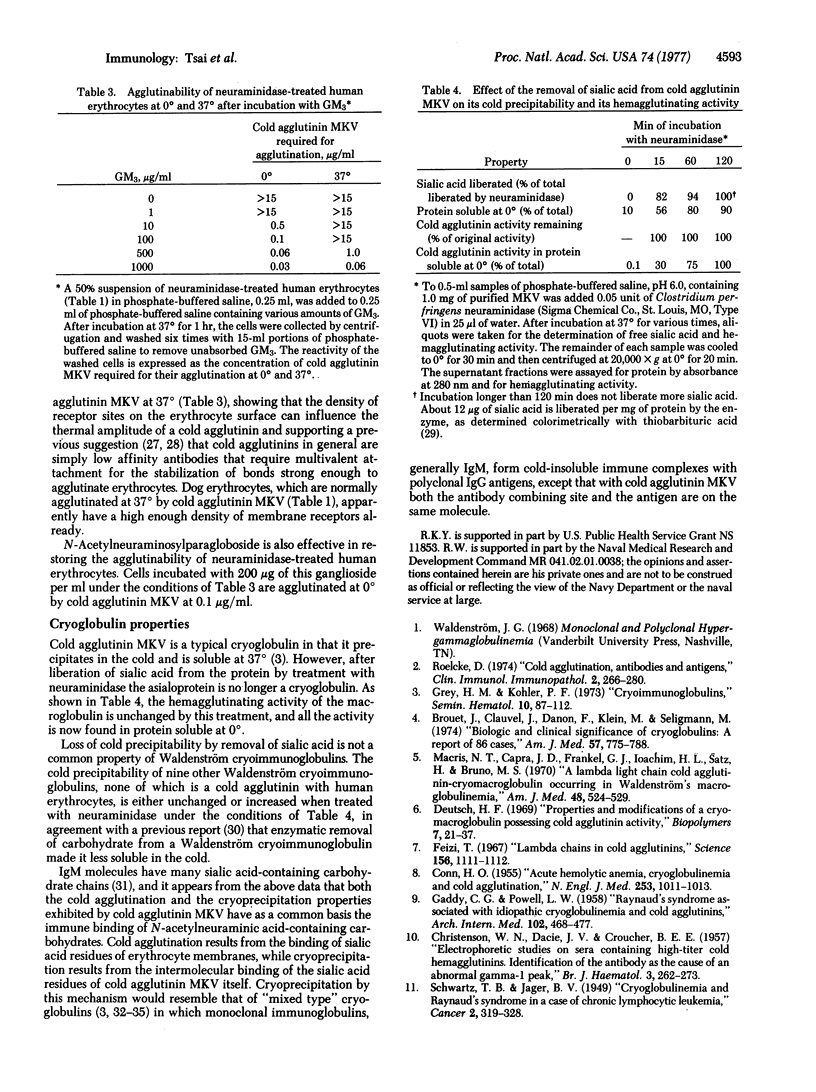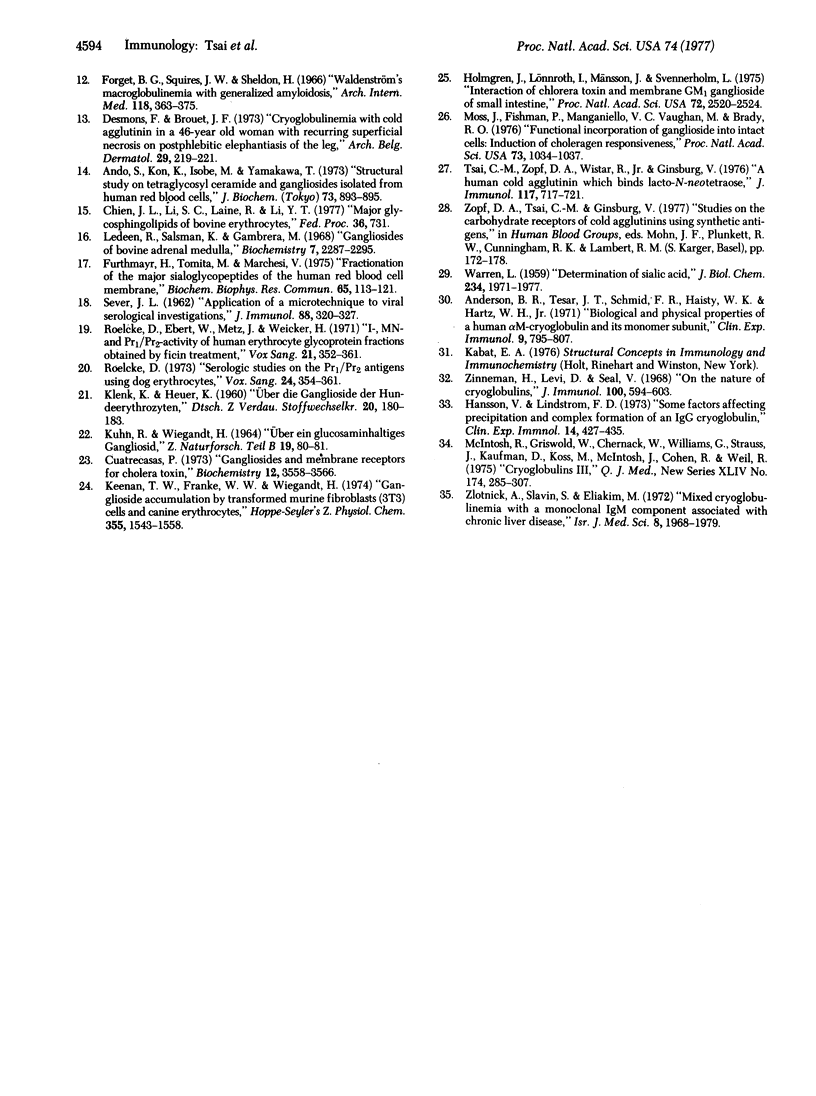Abstract
A purified human monoclonal IgM(κ) (cold agglutinin MKV) has been characterized as both a cold agglutinin and a cryoglobulin. Since its reactivity with human erythrocytes but not with dog erythrocytes is reduced by treatment of the cells with ficin and its reactivity with both is abolished by treatment of the cells with neuraminidase, it has by definition Pr2 specificity [Roelcke, D. (1974) Clin. Immunol. Immunopath. 2, 266-280]. Presumably, the membrane receptors for cold agglutinin MKV are sialic acid-containing glycoproteins in human cells and sialic acid-containing glycolipids in dog cells. Agglutination of erythrocytes is specifically inhibited by II3-N-acetylneuraminosyllactosylceramide (GM3) and N-acetylneuraminosylparagloboside but not by their N-glycolylneuraminosyl forms or by lactosylceramide or paragloboside, and the reactivity of neuraminidase-treated cells can be restored by allowing them to absorb either GM3 or N-acetylneuraminosylparagloboside. When large amounts of ganglioside are absorbed, the cells are agglutinated not only in the cold, but also at 37°, showing that the density of receptor sites on the erythrocyte surface can influence the thermal amplitude of cold agglutinins. Liberation of sialic acid from cold agglutinin MKV by treatment with neuraminidase (acylneuraminosyl hydrolase; EC 3.2.1.18) does not affect its agglutinating properties but the asialoprotein is no longer a cryoglobulin. Apparently the physical basis for its precipitation in the cold is the intermolecular immune binding of N-acetylneuraminosyl residues.
Keywords: receptors, glycoproteins, glycolipids, erythrocytes, blood groups
Full text
PDF



Selected References
These references are in PubMed. This may not be the complete list of references from this article.
- Andersen B. R., Tesar J. T., Schmid F. R., Haisty W. K., Hartz W. H., Jr Biological and physical properties of a human m-cryoglobulin and its monomer subunit. Clin Exp Immunol. 1971 Dec;9(6):795–807. [PMC free article] [PubMed] [Google Scholar]
- Ando S., Kon K., Isobe M., Yamakawa T. Structural study on tetraglycosyl ceremide and gangliosides isolated from human red blood cells. J Biochem. 1973 Apr;73(4):893–895. doi: 10.1093/oxfordjournals.jbchem.a130152. [DOI] [PubMed] [Google Scholar]
- Brouet J. C., Clauvel J. P., Danon F., Klein M., Seligmann M. Biologic and clinical significance of cryoglobulins. A report of 86 cases. Am J Med. 1974 Nov;57(5):775–788. doi: 10.1016/0002-9343(74)90852-3. [DOI] [PubMed] [Google Scholar]
- CHRISTENSON W. N., DACIE J. V., CROUCHER B. E., CHARLWOOD P. A. Electrophoretic studies on sera containing high-titre cold haemagglutinins: identification of the antibody as the cause of an abnormal gamma 1 peak. Br J Haematol. 1957 Jul;3(3):262–275. doi: 10.1111/j.1365-2141.1957.tb05795.x. [DOI] [PubMed] [Google Scholar]
- CONN H. O. Acute hemolytic anemia, cryoglobulinemia and cold agglutination; report of a case. N Engl J Med. 1955 Dec 8;253(23):1011–1013. doi: 10.1056/NEJM195512082532303. [DOI] [PubMed] [Google Scholar]
- Cuatrecasas P. Gangliosides and membrane receptors for cholera toxin. Biochemistry. 1973 Aug 28;12(18):3558–3566. doi: 10.1021/bi00742a032. [DOI] [PubMed] [Google Scholar]
- Desmons F., Brouet J. F. Cryoglobulinémie avec agglutinines froides chez nne femme de 46 ans, présentant des nécroses superficielles récidivantes sur éléphantiasis postphlebitique de la jambe. Arch Belg Dermatol Syphiligr. 1973 Jul-Sep;29(3):219–221. [PubMed] [Google Scholar]
- Deutsch H. F. Properties and modifications of a cryomacroglobulin possessing cold agglutinin activity. Biopolymers. 1969;7(1):21–37. doi: 10.1002/bip.1969.360070104. [DOI] [PubMed] [Google Scholar]
- Feizi T. Lambda chains in cold agglutinins. Science. 1967 May 26;156(3778):1111–1112. doi: 10.1126/science.156.3778.1111. [DOI] [PubMed] [Google Scholar]
- Forget B. G., Squires J. W., Sheldon H. Waldenström's macroglobulinemia with generalized amyloidosis. Arch Intern Med. 1966 Oct;118(4):363–375. [PubMed] [Google Scholar]
- Furthmayr H., Tomita M., Marchesi V. T. Fractionation of the major sialoglycopeptides of the human red blood cell membrane. Biochem Biophys Res Commun. 1975 Jul 8;65(1):113–121. doi: 10.1016/s0006-291x(75)80068-4. [DOI] [PubMed] [Google Scholar]
- GADDY C. G., POWELL L. W., Jr Raynaud's syndrome associated with idiopathic cryoglobulinemia and cold agglutinins; report of a case and discussion of classification of cryoglobulinemia. AMA Arch Intern Med. 1958 Sep;102(3):468–477. doi: 10.1001/archinte.1958.00030010468020. [DOI] [PubMed] [Google Scholar]
- Grey H. M., Kohler P. F. Cryoimmunoglobulins. Semin Hematol. 1973 Apr;10(2):87–112. [PubMed] [Google Scholar]
- Hansson U. B., Lindström F. D. Some factors affecting precipitation and complex formation of an IgG cryoglobulin. Clin Exp Immunol. 1973 Jul;14(3):427–435. [PMC free article] [PubMed] [Google Scholar]
- Holmgren J., Lönnroth I., Månsson J., Svennerholm L. Interaction of cholera toxin and membrane GM1 ganglioside of small intestine. Proc Natl Acad Sci U S A. 1975 Jul;72(7):2520–2524. doi: 10.1073/pnas.72.7.2520. [DOI] [PMC free article] [PubMed] [Google Scholar]
- KLENK K., HEUER K. [On gangliosides of dog erythrocytes]. Dtsch Z Verdau Stoffwechselkr. 1960 Nov;20:180–183. [PubMed] [Google Scholar]
- KUHN R., WIEGANDT H. UBER EIN GLUCOSAMINHALTIGES GANGLIOSID. Z Naturforsch B. 1964 Jan;19:80–81. [PubMed] [Google Scholar]
- Keenan T. W., Franke W. W., Wiegandt H. Ganglioside accumulation by transformed murine fibroblasts (3T3) cells and canine erythrocytes. Hoppe Seylers Z Physiol Chem. 1974 Dec;355(12):1543–1548. doi: 10.1515/bchm2.1974.355.2.1543. [DOI] [PubMed] [Google Scholar]
- Ledeen R., Salsman K., Cabrera M. Gangliosides of bovine adrenal medulla. Biochemistry. 1968 Jun;7(6):2287–2295. doi: 10.1021/bi00846a035. [DOI] [PubMed] [Google Scholar]
- Macris N. T., Capra J. D., Frankel G. J., Ioachim H. L., Satz H., Bruno M. S. A lambda light chain cold agglutinin-cryomacroglobulin occurring in Waldenström's macroglobulinemia. Am J Med. 1970 Apr;48(4):524–529. doi: 10.1016/0002-9343(70)90054-9. [DOI] [PubMed] [Google Scholar]
- McIntosh R. M., Griswold W. R., Chernack W. B., Williams G., Strauss J., Kaufman D. B., Koss M. N., McIntosh J. R., Cohen R., Weil R., 3rd Cryoglobulins. III. Further studies on the nature, incidence, clinical, diagnostic, prognostic, and immunopathologic significance of cryoproteins in renal disease. Q J Med. 1975 Apr;44(174):285–307. [PubMed] [Google Scholar]
- Moss J., Fishman P. H., Manganiello V. C., Vaughan M., Brady R. O. Functional incorporation of ganglioside into intact cells: induction of choleragen responsiveness. Proc Natl Acad Sci U S A. 1976 Apr;73(4):1034–1037. doi: 10.1073/pnas.73.4.1034. [DOI] [PMC free article] [PubMed] [Google Scholar]
- Roelcke D. Cold agglutination. Antibodies and antigens. Clin Immunol Immunopathol. 1974 Jan;2(2):266–280. doi: 10.1016/0090-1229(74)90044-0. [DOI] [PubMed] [Google Scholar]
- Roelcke D., Ebert W., Metz J., Weicker H. I-, MN- and Pr1/Pr2-activity of human erythrocyte glycoprotein fractions obtained by ficin treatment. Vox Sang. 1971 Oct;21(4):352–361. doi: 10.1111/j.1423-0410.1971.tb04790.x. [DOI] [PubMed] [Google Scholar]
- Roelcke D. Serological studies on the Pr 1 -Pr 2 antigens using dog erythrocytes. Differentiation of Pr 2 from Pr 1 and detection of a Pr 1 heterogeneity: Pr 1h -Pr 1d . Vox Sang. 1973 Apr;24(4):354–361. doi: 10.1111/j.1423-0410.1973.tb02653.x. [DOI] [PubMed] [Google Scholar]
- SEVER J. L. Application of a microtechnique to viral serological investigations. J Immunol. 1962 Mar;88:320–329. [PubMed] [Google Scholar]
- Tsai C. M., Zopf D. A., Wistar R., Jr, Ginsburg V. A human cold agglutinin which binds lacto-N-neotetraose. J Immunol. 1976 Sep;117(3):717–721. [PubMed] [Google Scholar]
- WARREN L. The thiobarbituric acid assay of sialic acids. J Biol Chem. 1959 Aug;234(8):1971–1975. [PubMed] [Google Scholar]
- Zinneman H. H., Levi D., Seal U. S. On the nature of cryoglobulins. J Immunol. 1968 Mar;100(3):594–603. [PubMed] [Google Scholar]
- Zlotnick A., Slavin S., Eliakim M. Mixed cryoglobulinemia with a monoclonal IgM component, associated with chronic liver disease. Isr J Med Sci. 1972 Dec;8(12):1968–1979. [PubMed] [Google Scholar]


